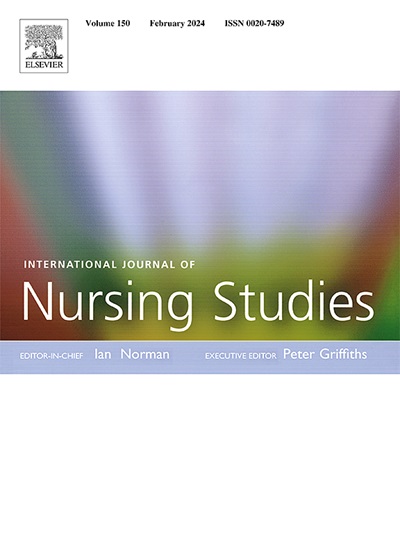剖宫产术后皮肤接触和母乳喂养:干预研究的系统回顾和荟萃分析
IF 7.5
1区 医学
Q1 NURSING
引用次数: 0
摘要
母乳喂养作为改善孕产妇和新生儿健康结果的一个因素已被广泛研究。在卫生保健服务中,已提出立即或早期皮肤接触干预措施,以提高剖腹产后母乳喂养或纯母乳喂养率,尽管研究结果尚无定论。目的:本系统综述和荟萃分析旨在综合现有的关于剖宫产后妇女和新生儿早期或立即皮肤接触和母乳喂养的证据。方法系统检索MEDLINE、EMBASE、Cochrane Library和Web of Science数据库自成立至2024年6月的文献。早期或立即皮肤接触的影响被报告为相对风险(rr), 95%可信区间(ci)由原始文章提供。使用DerSimonan和Laird方法计算汇总估计。干预组接受早期或立即皮肤接触,对照组接受剖宫产后的标准护理。采用Cochrane随机对照试验偏倚风险评估工具(RoB 2)和非随机干预研究偏倚风险评估工具(ROBINS-I)评估随机对照试验的偏倚风险。采用漏斗图不对称和Egger检验评估发表偏倚。使用Zotero参考文献管理器和Stata 17软件。结果共纳入8项随机对照试验和3项准实验研究,共纳入受试者1.990人。结果表明,皮肤接触使首次附着时间缩短51.73 min (95% CI: - 68.54 ~ - 34.91;I2: 85.3),增加了出生后前2小时的母乳喂养率(RR: 4.86;95% CI: 2.71 ~ 7.01;I2: 44.1)和出院时纯母乳喂养率(RR: 1.69;95% CI 1.36 ~ 2.01;I2: 13.7),但出生后1个月或更晚的纯母乳喂养率没有(RR: 1.13;95% CI 0.73 ~ 1.54;I2: 0.0)。结论剖宫产后早期或立即皮肤接触可提高护理期间母乳喂养率和纯母乳喂养率。需要进行较长随访时间的试验,以评估基于早期或直接皮肤接触的干预措施是否能长期保持其有效性,并澄清早期或立即皮肤接触对早产新生儿或具有某些健康状况的妇女是否安全。本文章由计算机程序翻译,如有差异,请以英文原文为准。
Skin-to-skin contact and breastfeeding after caesarean section: A systematic review and meta-analysis of intervention studies
Background
Breastfeeding has been widely studied as a factor that improves maternal and newborn health outcomes. Immediate or early skin-to-skin contact interventions have been proposed in health care services to increase breastfeeding or exclusive breastfeeding rates following caesarean births although the findings are inconclusive.
Objective
This systematic review and meta-analysis aimed to synthesize the available evidence on early or immediate skin-to-skin contact and breastfeeding in women and newborns following caesarean birth.
Methods
A systematic search was performed using in the MEDLINE, EMBASE, Cochrane Library and Web of Science databases from inception to June 2024. The effects of early or immediate skin-to-skin contact were reported as relative risks (RRs) with 95 % confidence intervals (CIs) provided by the original articles. Pooled estimates were calculated using the DerSimonan and Laird methods. The intervention groups received early or immediate skin-to-skin contact and the control group received standard care after caesarean birth. The risk of the bias of the randomized controlled trials was assessed using the Cochrane risk of bias tool for randomized controlled trials (RoB 2) and the risk of bias in nonrandomized studies of interventions (ROBINS-I) assessment tool for nonrandomized studies. Publication bias was assessed with funnel plot asymmetry and Egger's test. Zotero reference manager and Stata 17 software were used.
Results
Eight randomized controlled trials and three quasiexperimental studies involving a total of 1.990 participants were included. The findings indicate that skin-to-skin contact decreased the time to first attachment by 51.73 min (95 % CI: − 68.54 to − 34.91; I2: 85.3), increased the breastfeeding rates in the first 2 h after birth (RR: 4.86; 95 % CI: 2.71 to 7.01; I2: 44.1) and the exclusive breastfeeding rate at discharge (RR: 1.69; 95 % CI 1.36 to 2.01; I2: 13.7), but not the exclusive breastfeeding rate at one month from birth or later (RR: 1.13; 95 % CI 0.73 to 1.54; I2: 0.0).
Conclusion
This study revealed that early or immediate skin-to-skin contact after caesarean birth improved breastfeeding rates and exclusive breastfeeding rates during the health care stay. Trials with longer follow-up times are needed to assess whether interventions based on early or immediate skin-to-skin contact maintain their effectiveness over time and to clarify whether early or immediate skin-to-skin contact is safe for preterm newborns or women with certain health conditions.
求助全文
通过发布文献求助,成功后即可免费获取论文全文。
去求助
来源期刊
CiteScore
15.00
自引率
2.50%
发文量
181
审稿时长
21 days
期刊介绍:
The International Journal of Nursing Studies (IJNS) is a highly respected journal that has been publishing original peer-reviewed articles since 1963. It provides a forum for original research and scholarship about health care delivery, organisation, management, workforce, policy, and research methods relevant to nursing, midwifery, and other health related professions. The journal aims to support evidence informed policy and practice by publishing research, systematic and other scholarly reviews, critical discussion, and commentary of the highest standard. The IJNS is indexed in major databases including PubMed, Medline, Thomson Reuters - Science Citation Index, Scopus, Thomson Reuters - Social Science Citation Index, CINAHL, and the BNI (British Nursing Index).

 求助内容:
求助内容: 应助结果提醒方式:
应助结果提醒方式:


